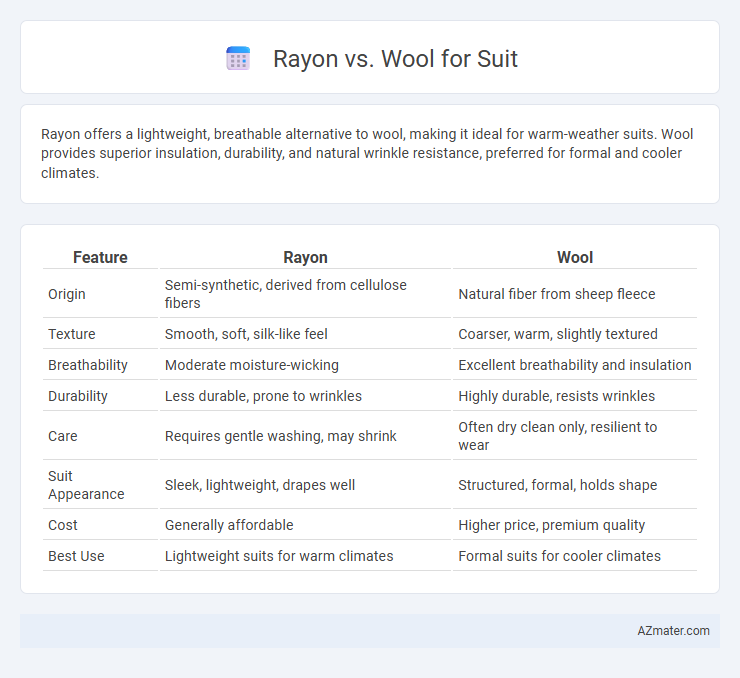Rayon offers a lightweight, breathable alternative to wool, making it ideal for warm-weather suits. Wool provides superior insulation, durability, and natural wrinkle resistance, preferred for formal and cooler climates.
Table of Comparison
| Feature | Rayon | Wool |
|---|---|---|
| Origin | Semi-synthetic, derived from cellulose fibers | Natural fiber from sheep fleece |
| Texture | Smooth, soft, silk-like feel | Coarser, warm, slightly textured |
| Breathability | Moderate moisture-wicking | Excellent breathability and insulation |
| Durability | Less durable, prone to wrinkles | Highly durable, resists wrinkles |
| Care | Requires gentle washing, may shrink | Often dry clean only, resilient to wear |
| Suit Appearance | Sleek, lightweight, drapes well | Structured, formal, holds shape |
| Cost | Generally affordable | Higher price, premium quality |
| Best Use | Lightweight suits for warm climates | Formal suits for cooler climates |
Introduction: Choosing the Best Fabric for Suits
Rayon suits offer affordability and lightweight comfort, making them suitable for warmer climates, while wool suits excel in durability, breathability, and temperature regulation, ideal for year-round wear. Wool's natural fibers provide superior wrinkle resistance and a luxurious drape, enhancing overall suit appearance and longevity. Selecting between rayon and wool depends on climate, budget, and desired fabric performance for professional settings.
What is Rayon? Key Characteristics
Rayon is a semi-synthetic fiber made from regenerated cellulose, often derived from wood pulp, known for its silk-like feel and excellent breathability. It drapes well, resists wrinkles, and absorbs moisture efficiently, making it a comfortable option for lightweight suits. Unlike wool, rayon lacks natural insulation and durability, requiring careful maintenance to prevent shrinking and stretching.
What is Wool? Key Characteristics
Wool is a natural fiber obtained from sheep, renowned for its excellent insulation, breathability, and moisture-wicking properties. Its crimped fibers provide elasticity and durability, making wool suits wrinkle-resistant and long-lasting. The fiber's natural lanolin content offers water repellency, enhancing comfort and protection in various weather conditions.
Comfort and Breathability: Rayon vs Wool
Rayon suits offer a lightweight and smooth texture that enhances comfort in warm weather, while wool suits provide better insulation and moisture-wicking properties ideal for cooler climates. Wool fibers naturally regulate body temperature and allow superior breathability, reducing sweat accumulation during prolonged wear. Rayon, being a semi-synthetic fiber, lacks the same thermoregulation and moisture control capabilities, making it less breathable compared to wool in varied environmental conditions.
Durability and Longevity Comparison
Wool suits offer superior durability and longevity due to their natural fiber structure, which resists wear and maintains shape over time, making them ideal for frequent use. Rayon suits, while more affordable and lightweight, tend to be less durable as synthetic fibers are prone to pilling, stretching, and faster degradation with regular wear. Investing in wool ensures a longer-lasting suit that retains its appearance and functionality through repeated use and cleaning cycles.
Appearance and Style: Which Looks Better?
Rayon suits offer a smooth, shiny finish that mimics silk, providing a modern, polished look ideal for stylish, fashion-forward wearers. Wool suits boast a natural texture with rich depth and density, delivering a classic, timeless elegance perfect for formal and business settings. The choice between rayon and wool ultimately depends on whether you prefer a sleek, glossy appearance or a sophisticated, textured style.
Care and Maintenance Requirements
Rayon suits require gentle hand washing or dry cleaning to prevent shrinking and fabric damage, as the fiber is sensitive to moisture and heat. Wool suits benefit from regular brushing and airing to remove dirt and odors, with professional dry cleaning recommended every few wears to maintain fabric integrity. Proper storage in breathable garment bags and avoiding prolonged sunlight exposure are essential for both materials to extend the lifespan of the suits.
Cost Differences Between Rayon and Wool Suits
Rayon suits are significantly more affordable than wool suits due to the lower cost of synthetic fibers compared to natural wool. Wool suits generally come with a higher price tag because of their superior durability, breathability, and luxury appeal. Choosing rayon can reduce expenses by up to 50% while sacrificing some quality and longevity found in fine wool suits.
Suitability for Different Climates and Occasions
Rayon suits offer lightweight breathability ideal for warm and humid climates, providing comfort during summer events or indoor gatherings. Wool suits excel in cooler climates due to their natural insulation and moisture-wicking properties, making them suitable for business settings and formal occasions in fall and winter. Choosing between rayon and wool depends on balancing temperature regulation needs with the formality of the event.
Conclusion: Which Fabric Should You Choose?
Rayon suits offer affordability, breathability, and a smooth drape suitable for warm climates, while wool suits provide superior durability, insulation, and wrinkle resistance, ideal for year-round wear and formal occasions. Choosing between rayon and wool depends on your priorities: budget-conscious buyers favor rayon for its cost-effectiveness, whereas those seeking longevity, natural fiber benefits, and classic elegance prefer wool. For a versatile, high-quality suit with lasting performance, wool remains the premium fabric choice.

Infographic: Rayon vs Wool for Suit
 azmater.com
azmater.com